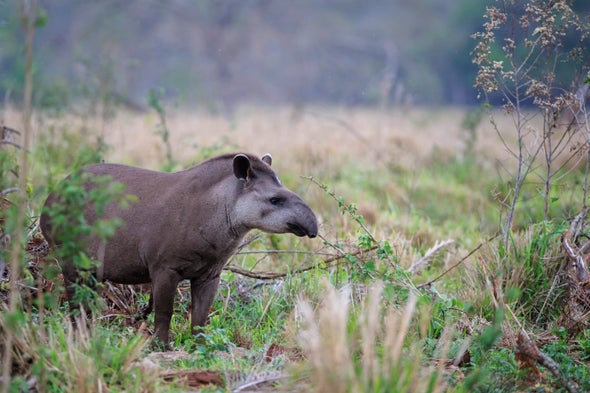(单词翻译:单击)
听力文本
This is Scientific American's 60-second Science. I'm Jason Goldman.
The Amazon rain forest is under threat. Fragmentation, fires and climate change are just a few of the hazards. In natural, intact forests, animals that eat fruits help to keep the forest in a constant state of regeneration since they deposit seeds in their droppings as they travel. Could the same process help restore areas degraded by fire?
"There are a lot of tapirs walking around the study area. And they, of course, poop a lot, because they are huge herbivores."
Lucas Paolucci from Brazil's Amazon Environmental Research Institute.
"So our team asked whether they could be walking around and eventually helping to reforest this area through their poops and, of course, the seeds that are within it."
Tapirs are the largest terrestrial mammals left in the Amazon rain forest. Imagine a 500-pound pig but with a small elephant trunk on its face—that's sort of what a lowland tapir looks like. The species is threatened with extinction, but certain areas still have quite a few tapirs roaming around.

Using a combination of camera traps, aerial imagery and field observations, the researchers measured the density and abundance of tapir droppings in three different parts of the rain forest over the course of seven years. One test plot was experimentally burned each year, one was burned every three years, and one was left completely intact.
"We saw that tapirs were occurring two times more often in disturbed areas than the unburned plots and also dispersing three times more seeds."
That's a lot of seeds. Extrapolating from the data, in intact forests, a single tapir deposits almost 3,000 seeds in a single hectare, or 10,000 square meters. But in burned areas, the animals drop nearly 10,000 seeds. And while researchers don't know how many seeds can germinate after a trip through a tapir's digestive system, fewer than one percent of such seeds appeared damaged.
But tapirs are just part of the equation. After they do a number two, dung beetles get to work forming the scat into balls before burying them, seeds included. Paolucci is now looking at whether dung beetles, like the tapir dung, are also more abundant in recently burned areas.
Putting tapirs to work doing what they already do best is perhaps the cheapest method for large-scale tropical forest restoration. Such renewal is critical for carbon sequestration, biodiversity preservation, and much more. Tapirs alone won't do the job alone; their work would help lower the price tag.
Thanks for listening for Scientific American's 60-second Science. I'm Jason Goldman.
参考译文
这里是科学美国人——60秒科学。我是杰森·古德曼。
亚马逊雨林正受到威胁。破碎化、火灾和气候变化只几个小危害。在自然完整的森林中,吃水果的动物有助于保持森林的不断更新,因为它们在旅行时会将种子存放在粪便中。同样的过程能帮助恢复被火灾破坏的地区吗?
“有很多貘在研究区里走动。当然,它们会大便,因为它们是大型食草动物。”
巴西亚马逊环境研究所的卢卡斯·保卢奇说到。
“因此,我们的研究团队想知道它们是否能四处走动,最终通过它们的粪便,当然还有里面的种子,来帮助这一地区重新造林。”
貘是亚马逊雨林中现存最大的陆地哺乳动物。想象一下,一只500磅重的猪,但脸上长着一个小象鼻,这就是低地貘的样子。该物种正面临灭绝的威胁,但某些地区仍有相当多的貘在四处游荡。
研究人员使用相机陷阱、航空影像和实地观察相结合的方法,在七年的时间里测量了热带雨林三个不同地区貘粪便的密度和丰度。其中一块实验区每年都要实验性地烧一次,另一块每三年烧一次,最后一块完好无损。
“我们发现,貘在受干扰地区出现的频率是未被烧毁地区的两倍,而且散播的种子也要多出三倍。”
那是很多种子。根据这些数据推断,在完整的森林中,一只貘在一公顷(即10000平方米)的土地上储存了近3000颗种子。但在被烧毁的地区,这些动物会撒下近1万粒种子。虽然研究人员不知道有多少种子可以在经过貘的消化系统后发芽,但只有不到1%的种子出现了损伤。
但貘只是等式的一部分。进行完第二步之后,蜣螂开始将粪便滚成球状,然后将含有种子的粪便埋起来。保卢奇现在正在研究蜣螂是否像貘的粪便一样,在最近被烧毁的地区也大量存在。
让貘做它们们已经做得最好的工作,也许是大规模热带森林恢复的最便宜的方法。这种更新对于碳封存、生物多样性保护等都至关重要。貘不能单独完成这项工作,但它们的工作将有助于降低价格。
谢谢大家收听科学美国人——60秒科学。我是杰森·古德曼。
译文为可可英语翻译,未经授权请勿转载!
重点讲解
重点讲解:
1. roam round 漫步;漫游;游荡;闲逛;
There were gangs of kids on motorbikes roaming around.
过去有成群结队的年轻人骑着摩托车四处游荡。
2. extrapolate from 推断;推知;
Extrapolating from his American findings, he reckons about 80% of these deaths might be attributed to smoking.
根据他在美国的调查结果推断,他估计这些人中约有80%可能死于吸烟。
3. part of 一些;部分;
The survey formed part of a larger programme of research.
这个调查是研究计划的一部分。
4. look at 检查,察看;
The examples we will look at have quite different emphases.
我们将要观察的例子所强调的重点很不相同。


